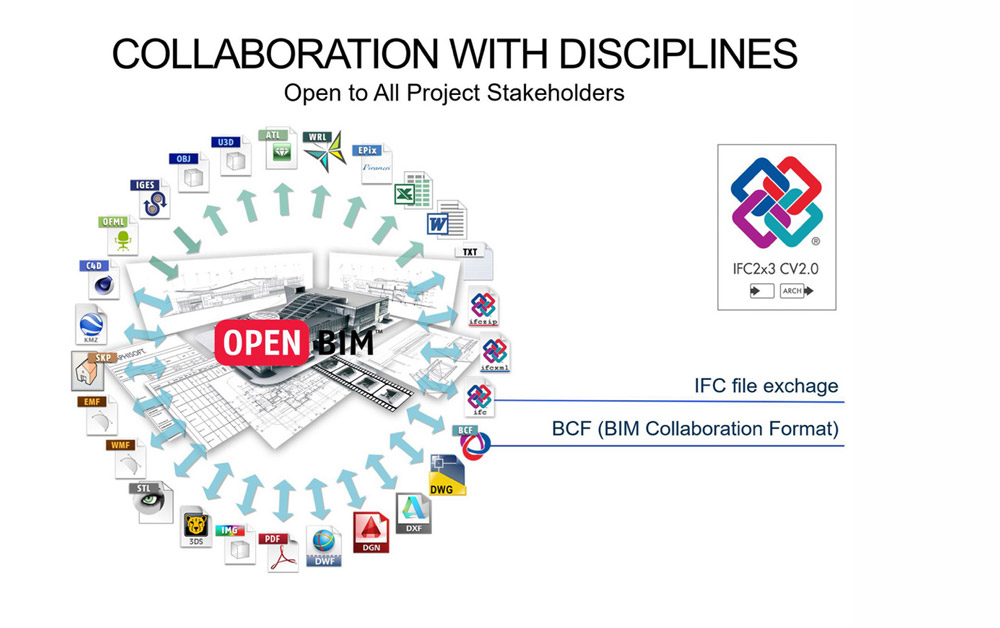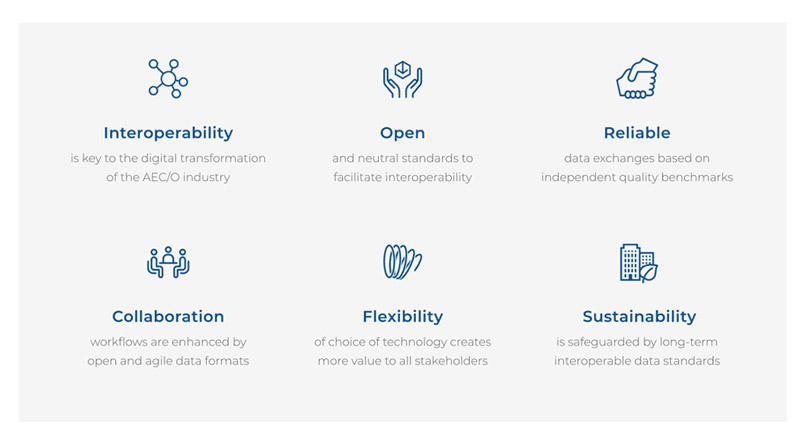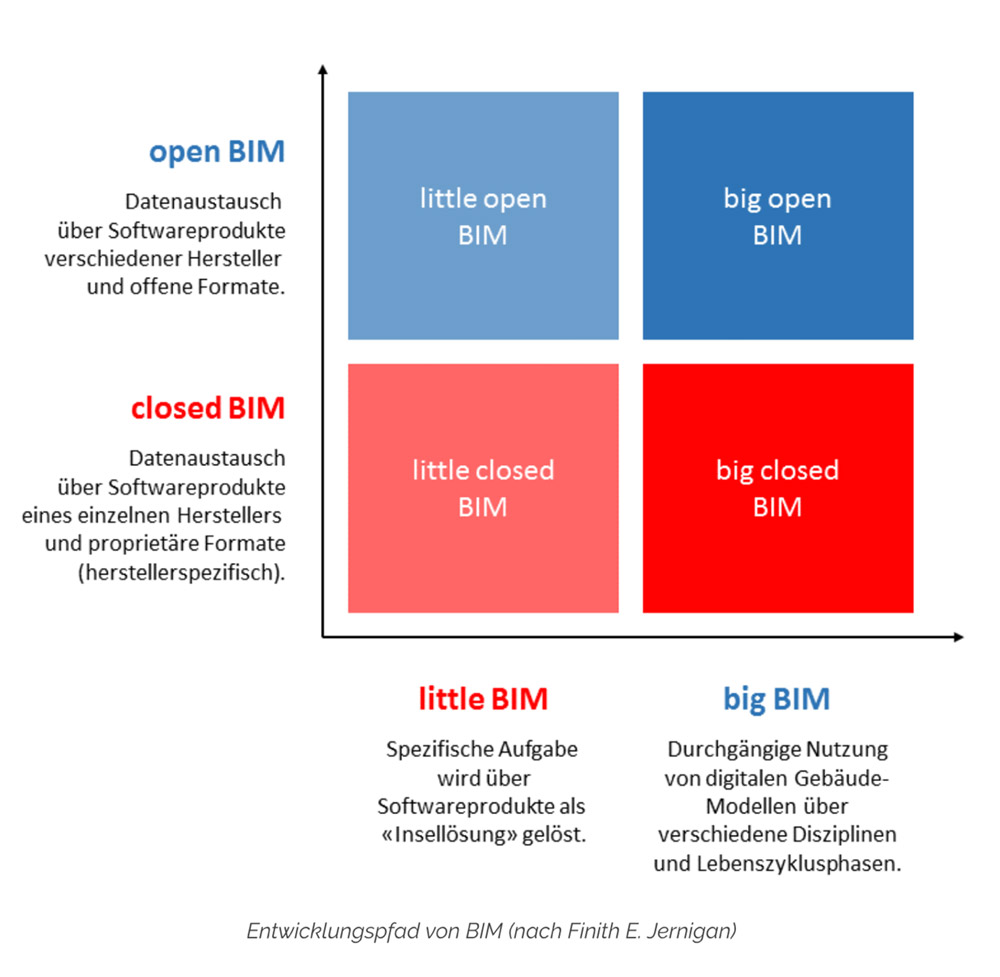Digital planning methods and process flows, especially BIM, are finding their way into architectural and planning offices in Germany and Austria, in Europe and worldwide. The benefits of BIM are now particularly recognized by those protagonists in construction who rely on interdisciplinary collaboration and integral planning. As BIM is being established, openBIM is becoming more and more important. But what does openBIM actually mean? And how does it determine collaboration in planning and construction? What other options are there to enable a process chain that is as consistently digital as possible when planning and building? We would like to answer these questions in the following blog post.
BIM means planning together and in a solution-oriented manner – and Identify sources of error early and avoid costly improvements during the construction phase and later in operation. However, it requires the interaction of the architectural office and specialist planners or the general contractor with his specialist engineers long before construction begins. The joint work on the building model or in the specialist models of the planning specialists creates more Planning and cost security even in early service phases. These striking BIM advantages have manifested themselves in many minds and almost everyone has already dealt with BIM more or less intensively. Now reached with openBIM a new term for working life that, like “BIM” some time ago, raises further questions.
openBIM describes the cross-manufacturer, software-independent and system-open data exchange between the various project partners.
openBIM – open and future-proof
Simply put: openBIM describes the cross-manufacturer, software-independent and system-open data exchange between the various project partners. Project partners can be architectural and specialist planning offices, construction companies or experienced specialist craftsmen. Each of them uses their own with openBIM own software to read and edit planning information. The exchange between those involved in the project takes place in the open formats IFC (Industry Foundation Classes) and BCF (BIM Collaboration Format). IFC was founded several decades ago by the independent organization buildingSMART developed, is constantly adapted and optimized for changing planning and construction processes; BCF was added a few years ago as a standard for the model-based exchange of comments and notes on planning.

The Nemetschek Groupto which NEVARIS has belonged for decades, has been relying on openBIM for many years and is committed to it OPEN BIM logo and the OPEN BIM charter to the high quality requirements that openBIM sets. A total of 13 brands come together under the group’s umbrella, which cover the entire building life cycle – from planning to tendering, implementation and use to conversion or recycling. openBIM creates the necessary Transparency in work processesdoes not exclude or grant anyone the obligation to use specific software Access to data from planning and execution throughout the entire operational phase of a building.
Those who work in an openBIM-oriented manner have, among other things, the advantage of not being restricted to specific software from just one manufacturer.
Anyone who works in an openBIM-oriented way has, among other things, the following Advantage of not being limited to specific software from just one manufacturer. Those involved can do theirs Convert software-specific 3D models into a manufacturer-neutral three-dimensional IFC file and transport the geometry and additional data on construction, materials, materials or areas of application and product properties within it. Component-oriented planning, now the state of the art in all professional planning programs for civil engineering, enables intelligent details that convey a variety of parameters and attributes. And it helps, that Interaction of specialist planning disciplines to facilitate sustainably.
closedBIM – a system with pitfalls
Another form of collaboration in the BIM project is the use of closedBIM. Work at it everyone involved in a building model at the same time, in the same manufacturer format and with the identical software. However, since this only works smoothly with the programs from a software family, they only rely on the solutions from a single manufacturer. The advantage: There are hardly any transmission errors when sending data and interpreting the model information. The decisive disadvantage: Everyone is required to work with this product or the software from a product family. And this despite the fact that they may have been successfully planning digitally for years with a different software solution. Nevertheless, closedBIM can certainly offer advantages if the same teams always work together in the projects. They make perfect use of the qualities of the software and have optimally adapted their processes to it.

openBIM fits into the construction process
Proper planning is important to create a high quality building. But in the end, what counts is the implementation on the construction site. openBIM also offers construction companies the option of working model-based – without your own CAD or BIM software. IFC-based BIM viewers, such as in the NEVARIS Build project software integrated, provide a first insight into the construction and design of a construction project. However, IFC can do much more. Components can be derived directly from the file (the IFC model) and individual items from the service books or element catalogs can be assigned to them.
Added to this is the Exact model-based mass and quantity determination via IFC with comprehensible calculation approaches: The precision comes from the building model previously created by the architecture or planning office. The construction company uses the IFC file as a calculation basis and can use it to determine important calculation approaches and resource use early in the project. Requirement for this: Previously jointly defined quality parameters for modeling (i.e. transferring the design as a 3D model in the CAD program) were adhered to. If there is a “clean” planning and the open IFC file is written from it, the workflow is completely digital and compliant with the rules, from the tender, the award to the billing.
Implement consistent digital processes
openBIM offers a wealth of options that closely link all partners in the planning and construction process. You can continue to work with your own software – using the IFC and BCF formats. NEVARIS has recognized the importance of openBIM. Not just as Co-creator of the Nemetschek Group’s OPEN BIM initiative NEVARIS is actively involved in the further development of open data exchange. Also in their construction software products NEVARIS build (D) and Success X (AT), NEVARIS is working intensively on this openBIM workflow to optimize for your customers.
Image credits: Sasin Paraksa/Shutterstock.com, Nemetschek Group, Planerwissen2Go.






